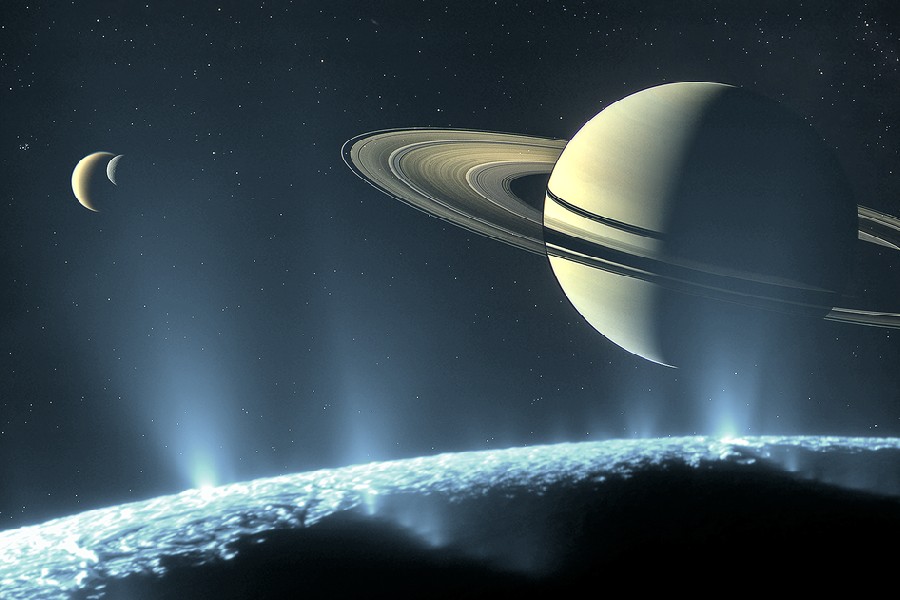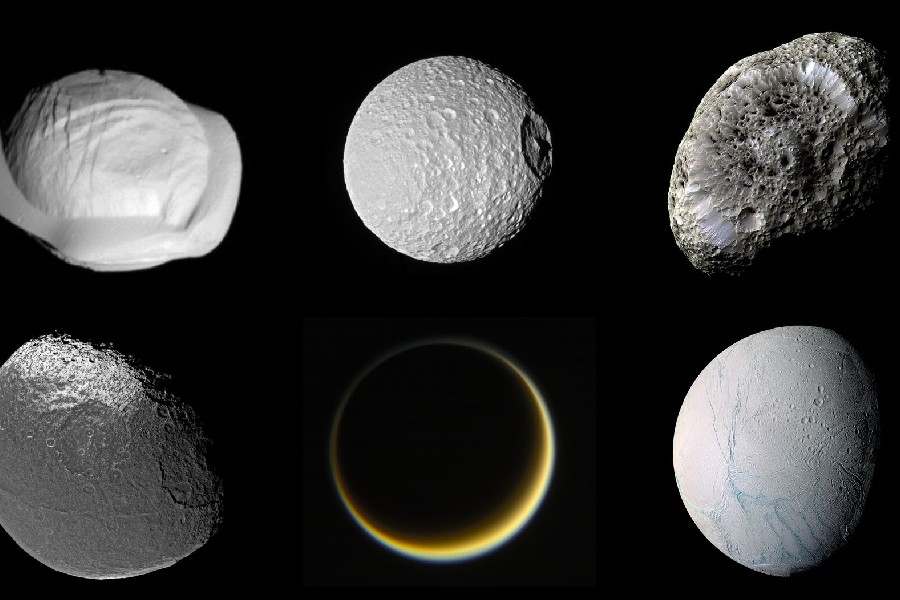Saturn possesses an intricate system of orbiting moons, each offering clues into cosmic mysteries waiting to be unlocked. What created the striking red streak across the tiny moon Daphnis? Do some of Saturn’s frozen moons conceal vast subsurface oceans? Let’s dive deeper into facts about the moons of Saturn!
Uncovering more facts about these diverse celestial bodies promises revelations regarding planetary evolution. This article explores some of Saturn’s lesser-known, unusually-shaped moons and compares their abnormal formations molded over eons by cosmic impacts.

Facts About the Moons of Saturn
- Saturn has over 146 confirmed moons, most relatively small icy bodies orbiting the giant ringed planet.
- The largest and most studied moon is hazy Titan, bigger than planet Mercury with a thick atmosphere.
- Saturn’s unique moons are studied by robotic spacecraft.
- Icy moons like Mimas, Enceladus, Tethys, and Rhea show evidence of past collisions and cosmic impacts that shaped their odd forms.
- Other small moons have mysterious reddish hues or are tapered like ravioli.
- Far-out moons Phoebe, Iapetus and more have retrograde orbits going opposite Saturn’s spin direction.
New observations continuously uncover more unexpected facts about Saturn’s many moons. Revelations about these lesser-known satellites are expanding our understanding of how Saturn and its rings developed in harmony with multiple orbiting moons over four billion years.
Each Saturn Moon Is Unique
Varying sizes and traits
Saturn hosts over 146 confirmed moons orbiting the planet, with vast differences in sizes from tiny moonlets just kilometers across to the gigantic Titan which is wider than the planet Mercury.
The surfaces of Saturn’s many moons show clear evidence of past collisions and impacts from asteroids and comets that have shaped each moon over eons.
In addition, the varying orbits and rotations of Saturn’s moons point to diverse origins and formation histories for how each unique sphere came to be.
Continuing studies by the Cassini spacecraft. Other probes have highlighted more oddities and uniquenesses of Saturn’s moons such as unusual grooves and ridge formations across the surface.
Surprising ratios of ice compared to rock, and puzzling deviations from expected orbits that reveal complex gravitational interactions. Each new world studied reveals new revelations about Saturn’s complex system of rings and satellites.
Titan the exception
Titan thoroughly outranks all other Saturn moons in terms of its sheer size, mass, and atmospheric density. At 3,200 miles (5,150 kilometers) in diameter, Titan dwarfs inner moons and even exceeds the sizes of Jupiter’s largest moons Ganymede and Callisto.
The dense nitrogen atmosphere blanketing Titan makes it more similar to a terrestrial planet compared to other mostly icy satellites.
Titan stands out as an exceptional case among Saturn’s extensive system of over 80 moons in many categories. It is truly an anomalous and unique world in our Earth’s solar system.
Characteristics of Saturn’s Moons
Size and mass in orbit
How mass affects orbits
Larger moons have more mass. Their gravity dominates nearby space around their orbits. It clears out debris to maintain clear orbital paths as they circle Saturn. Small moons and tiny moonlets orbit within gaps in the rings.
They do not have gravity to clear paths so embed safely within ring particle gaps. More mass also means a wider, farther orbit from Saturn. More gravity needed to balance the centrifugal forces from their rotation and revolution. So size and mass affect distance.
Standouts in terms of size
Titan is uniquely huge among Saturn’s moons, almost as wide in diameter as the planet Mercury. Titan thoroughly dwarfs all other moons in sheer size.
Enceladus is just 310 miles (500 kilometers) wide but shows surprises like spraying geysers and possibly hiding an ocean. Some tiny moonlets are not even tens of miles across yet maintain orbits within Saturn’s rings.
Rocky cores and icy crusts
Mid-sized moons’ makeups
Many mid-sized, frozen moons likely harbor dense rocky cores from early formations after the Solar System’s dawn, including Iapetus, Rhea, Dione, Tethys orbiting Saturn. These rocky centers are surrounded by softer, icy outer shells.
Thickness, purity, and density of ice crust layers varies remarkably between each moon. Creating complex dynamics within their deep interiors. Dione’s core is notably less dense than Tethys despite having comparable sizes – a mystery to unravel.
Pockmarked surfaces
Small, inner moons have short orbital periods, indicating formations from recent collisions versus early condensation. Hence, their surfaces are pockmarked heavily by craters.
But a few, like feisty Enceladus, show surprises may lay beneath their fractured facades. Such as subsurface oceans interacting with rocky cores to drive geysers.

Solid and liquid surfaces for some moons
Enceladus’ active ocean
Enceladus shows clear evidence of a global subsurface ocean under its thick icy crust, dynamically interacting with its rocky core deep below. This internal heating powers the remarkable fierce cryovolcanic geysers that erupt through tiger stripe fractures at the moon’s south pole.
Given the ongoing activity including emissions of simple organics, vast liquid water seas very likely churn far beneath the frozen exterior crust. Further analyses could reveal conditions possibly conducive to basic extraterrestrial lifeforms. An alluring target for more extensive future exploration.
Mimas and Iapetus contrasts
Iapetus, Saturn’s third-largest moon at just over 869 miles (1,400 kilometers) wide, has a notably odd, walnut-like external shape unlike any other moon. A mountainous ridge spans nearly halfway around Iapetus along its equator, reaching peaks over 12 miles (20 kilometers) high.
This highly unique form strongly indicates past internal heating led Iapetus to temporarily melt and re-form into this irregular exterior before fully re-freezing again over geological time.
The past heating caused Iapetus to temporarily melt, reform irregularly, and eventually fully re-freeze over geological time. Meanwhile, the much smaller moon Mimas follows a standard template as an internally frozen solid ice sphere.
Irregular and regular shapes for different moons
Rounded regular moons
Most of Saturn’s inner to mid-sized moons orbiting relatively near to the planet conform to rounded, roughly-spherical shapes. These include Mimas, Enceladus, Tethys, Dione, and Rhea along with other similarly sized frozen satellites.
Their overall rounded shapes generally indicate sufficient mass accumulated during formation for self-gravitation to smooth any irregularities into more uniform spheres. Even models of their deep interiors match rounded surface topology.
Irregular odd balls
However, some lesser moons orbiting much farther out maintain perplexingly irregular, distorted forms today. Such as the notably lumpy elongated shape of Epimetheus. As well as the small flattened quasi-ravioli-like form of the tiny moon Pan residing within Saturn’s rings.
What specific accretion processes could lead these to take such abnormal shapes, versus the spherical norms, remains an intriguing open question for researchers studying these distant Saturn system outliers.
The question is about what specific accretion processes could result in such irregular, non-spherical forms compared to the typical spherical shapes normally seen.
Locations of Major Moons Around Saturn
Inner cluster of moons
Major inner moons orbit relatively close to Saturn within its faint E Ring and magnetosphere. Mimas, Enceladus, Tethys, Dione, Rhea cluster between 62,000-311,000 miles (100,000-500,000 kilometers) from the planet’s cloud tops.These mid-sized moons substantially influence the structure of Saturn’s rings with their own gravitational pulls .
They orbit near the dense bands of icy particles. Some inner moons actively exchange material back and forth collisionally with the E ring in particular. This group of Saturnian moons likely formed alongside Saturn and its rings over 4.5 billion years ago at the dawn of the Solar System.
Far-out frozen moons
In contrast, many frozen minor moons orbit much farther from Saturn, at distances ranging between one to seven million miles away from the plant itself.
Iapetus, Hyperion, Phoebe, and other irregularly shaped smaller moons make up this distant group, orbiting at one to seven million miles from Saturn. The odd moon Phoebe in particular has a notably backwards orbit direction compared to Saturn’s spin.
These distant irregular moons are thought to have formed later, originating as wayfaring icy objects that were gravitationally captured by giant Saturn across its long history. They have relatively eccentric, inclined orbits indicative of their stranger origins from parts unknown.
Largest Moon – Titan
Truly remarkable world
Titan thoroughly outranks all of Saturn’s other 60+ moons in terms of its sheer size, high density, and atmospheric complexity. Over 3,100 miles (5,000 kilometers) in diameter, bear in mind planet Mercury itself is just 3,100 miles wide, so Titan nearly matches it.
Its thick nitrogen atmosphere dotted with photochemical haze makes Titan more reminiscent of a terrestrial planet than a standard frozen moon. Methane rain and lakes demonstrate exotic cryo-hydrological cycles alien to anywhere else in Earth’s Solar System.
Prime target for future exploration
Saturn’s giant moon Titan was studied extensively by the NASA/ESA Cassini spacecraft during over 130 close flybys. It was also analyzed directly by the European Huygens landing probe. However, Titan still holds many mysteries left to uncover in future decades by crews of human explorers and robotic research missions.
Conclusion
We have aimed to showcase the diversity across Saturn’s extensive system of confirmed moons. From analyzing orbital dynamics shaped by their varying sizes and masses, to contrasting their odd shapes hinting at past formation histories, we explored numerous distinguishing facts about the moons of Saturn.
Discovering surprises like subsurface oceans, while also better understanding expected traits like dense, icy compositions. It is hoped these insights illustrate what makes each shimmering, cratered sphere unique across the Saturnian skies.
